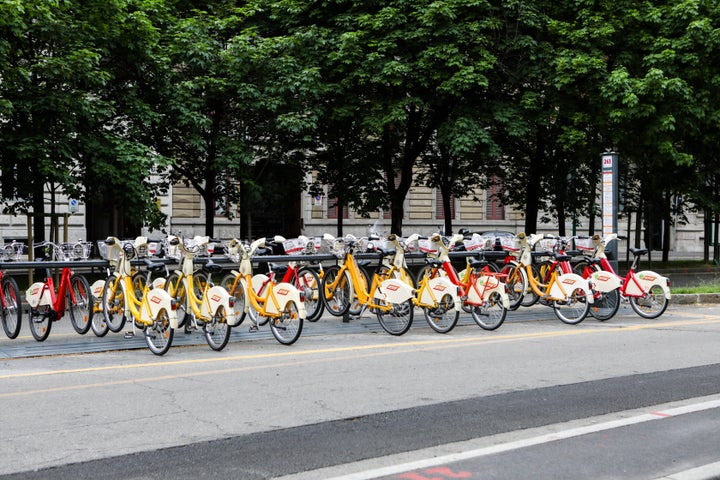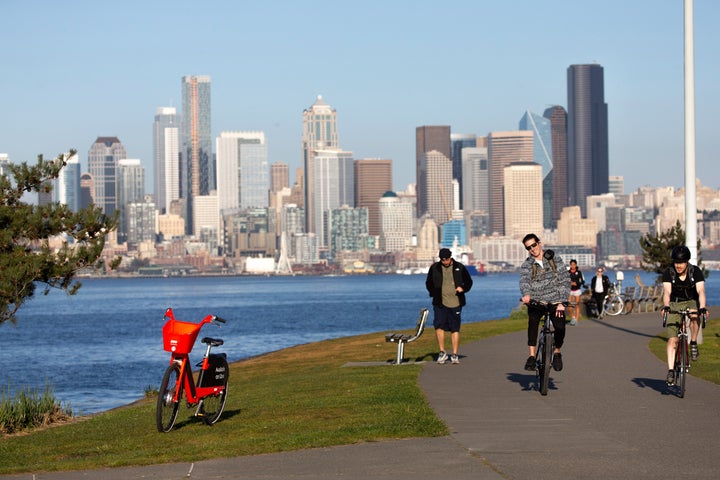Bikes are booming ― so much so that there’s currently a bicycle shortage in the U.S. as block-long lines stretch outside bike stores.
COVID-19 has drastically changed not only how much we travel but how we get around. With people looking to get out of the house while avoiding public transit, bicycles are suddenly an enticing choice. They promise speed, freedom and fresh air on newly quiet streets. Sales of bikes in the U.S. in March were nearly double what they were the previous year, and according to Eco-Counter, a cycling analysis company, biking levels in the western United States increased by 253% in late April.
As these new cyclists take to the streets, many are finding a world very different from pre-pandemic times, with pop-up bike lanes, expanded pedestrian spaces and roads closed to vehicles.
Last month, New York City Mayor Bill de Blasio announced that 40 miles of streets would be opened for socially distanced recreation, with plans to eventually expand to 100 miles ― meaning those streets will no longer be through-routes for motor traffic. New bike routes and expanded sidewalks will also be part of the picture. Los Angeles has a new temporary protected bike lane on the busy 7th Street in downtown, along with a handful of “slow streets,” closed to through traffic but still allowing residents to drive in and out.
Other cities are even more ambitious. In Seattle, 20 miles of slow streets will be made permanent, along with new bike lanes and expanded sidewalks. Bringing forward an existing bicycle plan, Oakland temporarily opened 74 miles of streets to walking and biking in April, before extending the program in May, with 75% support from residents.

It’s a trend that’s happening globally. In Montreal, more than 200 miles of biking and walking lanes are being built, more than half of them on a permanent basis, to help businesses reopen with physical distancing measures. Paris and Milan have built temporary bike lanes shadowing metro lines to replace transit trips.
Cycling brings plenty of benefits as our lives shrink during the pandemic. It allows us a form of socially distanced travel and exercise, and there’s a clear environmental advantage to swapping out cars and cabs for an emissions-free bicycle journey. There are also other, less obvious advantages, from boosting local businesses to actually making roads safer for everyone ― cyclists, pedestrians and even drivers.
While drivers tend to see cyclists as an inconvenience ― an obstacle to avoid, an annoyance to get past ― there’s plenty of evidence to suggest that cities with plentiful and safe cycling infrastructure can make roads better for cars.
The Netherlands is a good example. According to a Waze analysis of 38 countries, the northern European nation, famed for its expansive network of cycle paths, has the most satisfying roads for driving. The roads are quieter because people can choose to bike, rather than drive, for shorter trips. And bike lanes make streets more efficient: A bike lane 11.5 feet wide can carry seven times as many people per hour as a motor vehicle lane of the same width. The Dutch also have some of the safest streets in the world.

Evidence from the U.S. shows that where good cycling infrastructure exists, roads are safer for everyone. A review of 13 years of crash data from 12 large American cities between 2000 and 2012 found that bike routes meant fewer fatalities of all road users ― although that only happened with physically protected bike lanes, not painted lanes, which researchers found were actually worse than nothing. Cities with protected bike lanes saw a 44% decrease in road deaths and 50% fewer injuries, the study found.
“What it comes down to,” said Tara Goddard, assistant professor at Texas A&M University, “is everyone is safer when drivers are paying more attention, going slower, and on the lookout or have expectations about seeing other [road] users.”
If there’s a piece of infrastructure that helps slow people down, raises their expectations of seeing other people, or causes them to be less distracted, it makes people safer, Goddard notes. “Bike lanes, especially protected bike lanes, happen to be a way to do one or more of those things at the same time,” she said.
And when roads are safer, people are encouraged to take more environmentally friendly transit options. Alex Engel, program manager at the National Association of City Transportation Officials, puts it simply: “If you’re providing safe places for people to walk, people will walk. If you’re providing safe places for people to bike, people will bike.” More local biking and walking trips can free up transit capacity for essential workers, many of whom have to travel longer distances to work, Engel says.
If the current cycling adaptations in various U.S. cities become permanent, many experts believe they could help forestall a transportation crisis once we emerge from the pandemic. If everyone immediately jumps in their cars when cities reopen, streets could descend into chaos. As Jon Orcutt, former director of transportation policy for New York City and director of Bike NYC, puts it: When a fraction of New Yorkers took to their cars after Hurricane Sandy, there was “epic gridlock,” with “cars running all the way back into the suburbs from Manhattan” as people avoided public transit.
Some may be cynical about the prospects of the cycling boom continuing if and when we return to a more normal pace of life. But while the U.S., with its love of cars, may seem a million miles from someplace like the Netherlands, biking could remain a real option for many trips. U.S. commutes in most large metro areas are less than 10 miles, easily bikeable at a leisurely pace in less than an hour. In eight of the 10 most congested U.S. cities, “last mile” traffic speeds ― that is, the speed of a commuter’s final mile of travel ― are 12 mph or less. Add in bike lanes and electric bikes, which can transport riders at 15.5 mph with ease, and it becomes much easier to switch to two wheels.

There’s still the question of who takes priority on the roads and whether drivers will be willing to “give up” curbside parking spots or a driving lane, Goddard says. But she believes the community actually gains something from restricting motor traffic space: Narrower roads that require drivers to slow down can reduce weaving and other elements of faster, erratic driving that ultimately delay traffic ― as research from New York confirms.
Businesses can gain too, with evidence suggesting that increasing bike lanes can have positive effects on the local economy. The New York study found that streets with cycling infrastructure saw increased retail sales. Cyclists and pedestrians in Portland, Oregon, spend more per month in stores, bars and restaurants than drivers. A new bike lane in Seattle, replacing 12 street parking spaces, increased retail spend significantly.
Pedestrian and cycling space will be similarly valuable as businesses seek to reopen with physical distancing measures. Tampa, Florida, is permitting restaurant seating to expand into streets and curbside parking spots to help those businesses remain financially viable. Many other cities are looking to similar measures.
But if we want to create better streets that serve our economic, health and environmental needs, as the pandemic has starkly illustrated, we can’t forget the most vulnerable among us. This includes minority communities as well as risk-averse populations like women, children and the elderly.
“Infrastructure needs to be more comprehensive across the entire city,” said Lucy Mahoney, walking and cycling network manager for C40 Cities, a collaboration of 96 cities on tackling global warming. This is true, she said, “particularly for areas of lower income and Black and mixed-ethnicity populations.” Those areas often have little biking infrastructure or public transit, and fewer trees to shade the long wait for a bus.
“We’ve had some systemic issues with our transportation systems that have really been opened and magnified by this pandemic,” Engel said. “It’s not new that our streets have poor outcomes in terms of safety. It’s not new that our streets did not provide the best access for a lot of more marginalized groups and people, especially communities of color in the U.S. and other places.”
Investment in biking infrastructure can improve these outcomes ― but more than that, it can make cities and towns safer, more equitable and more pleasant for all of us, whether we choose to bike or not.
For more content and to be part of the “This New World” community, follow our Facebook page.
HuffPost’s “This New World” series is funded by Partners for a New Economy and the Kendeda Fund. All content is editorially independent, with no influence or input from the foundations. If you have an idea or tip for the editorial series, send an email to thisnewworld@huffpost.com.
